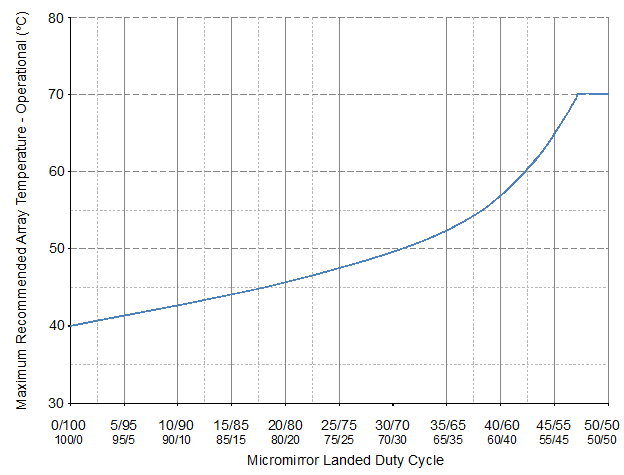DLPS153 October 2023 DLP651LE
PRODUCTION DATA
- 1
- 1 Features
- 2 Applications
- 3 Description
- 4 Revision History
- 5 Pin Configuration and Functions
-
6 Specifications
- 6.1 Absolute Maximum Ratings
- 6.2 Storage Conditions
- 6.3 ESD Ratings
- 6.4 Recommended Operating Conditions
- 6.5 Thermal Information
- 6.6 Electrical Characteristics
- 6.7 Timing Requirements
- 6.8 System Mounting Interface Loads
- 6.9 Micromirror Array Physical Characteristics
- 6.10 Micromirror Array Optical Characteristics
- 6.11 Window Characteristics
- 6.12 Chipset Component Usage Specification
-
7 Detailed Description
- 7.1 Overview
- 7.2 Functional Block Diagram
- 7.3 Feature Description
- 7.4 Optical Interface and System Image Quality Considerations
- 7.5 Micromirror Array Temperature Calculation
- 7.6 Micromirror Power Density Calculation
- 7.7 Window Aperture Illumination Overfill Calculation
- 7.8 Micromirror Landed-On/Landed-Off Duty Cycle
- 8 Application and Implementation
- 9 Layout
- 10Power Supply Recommendations
- 11Device and Documentation Support
- 12Mechanical, Packaging, and Orderable Information
Package Options
Mechanical Data (Package|Pins)
- FYM|149
Thermal pad, mechanical data (Package|Pins)
Orderable Information
6.4 Recommended Operating Conditions
Over operating free-air temperature range (unless otherwise noted). The
functional performance of the device specified in this data sheet is achieved
when operating the device within the limits defined by this table. No level of
performance is implied when operating the device above or below these
limits.
| MIN | NOM | MAX | UNIT | ||
|---|---|---|---|---|---|
| VOLTAGE SUPPLY | |||||
| VCC | Supply voltage for LVCMOS core logic(1) | 3.0 | 3.3 | 3.6 | V |
| VCCI | Supply voltage for LVDS Interface(1) | 3.0 | 3.3 | 3.6 | V |
| VOFFSET | Micromirror Electrode and HVCMOS voltage(1)(2) | 8.25 | 8.5 | 8.75 | V |
| VMBRST | Micromirror Bias / Reset Voltage(1) | –27 | 26.5 | V | |
| |VCC – VCCI| | Supply voltage delta (absolute value)(3) | 0 | 0.3 | V | |
| LVCMOS INTERFACE | |||||
| VIH | Input High Voltage | 1.7 | 2.5 | VCC + 0.3 | V |
| VIL | Input Low Voltage | –0.3 | 0.7 | V | |
| IOH | High Level Output Current | –20 | mA | ||
| IOL | Low Level Output Current | 15 | mA | ||
| tPWRDNZ | PWRDNZ pulse width(4) | 10 | ns | ||
| SCP INTERFACE | |||||
| ƒSCPCLK | SCP clock frequency(5) | 50 | 500 | kHz | |
| tSCP_PD | Propagation delay, clock to Q, from rising-edge of SCPCLK to valid SCPDO(6) | 0 | 900 | ns | |
| tSCP_DS | SCPDI clock setup time (before SCPCLK falling-edge)(6) | 800 | ns | ||
| tSCP_DH | SCPDI hold time (after SCPCLK falling-edge)(6) | 900 | ns | ||
| tSCP_NEG_ENZ | Time between falling-edge of SCPENZ and the rising-edge of SCPCLK(5) | 1 | us | ||
| SCP_POS_ENZ | Time between falling-edge of SCPCLK and the rising-edge of SCPENZ | 1 | us | ||
| tSCP_OUT_EN | Time required for SCP output buffer to recover after SCPENZ (from tristate) | 192/ƒDCLK | s | ||
| tSCP_PW_ENZ | SCPENZ inactive pulse width (high level) | 1 | 1/ƒscpclk | ||
| tr | Rise time (20% to 80%) | 200 | ns | ||
| tf | Fall time (80% to 20%) | 200 | ns | ||
| LVDS INTERFACE | |||||
| ƒCLOCK | Clock frequency for LVDS interface (all channels), DCLK(7) | 320 | 330 | MHz | |
| |VID| | Input differential voltage (absolute value)(8) | 100 | 400 | 600 | mV |
| VCM | Common mode voltage(8) | 1200 | mV | ||
| VLVDS | LVDS voltage(8) | 0 | 2000 | mV | |
| tLVDS_RSTZ | Time required for LVDS receivers to recover from PWRDNZ | 10 | ns | ||
| ZIN | Internal differential termination resistance | 95 | 105 | Ω | |
| ZLINE | Line differential impedance (PWB/trace) | 90 | 100 | 110 | Ω |
| ENVIRONMENTAL | |||||
| TARRAY | Array temperature, long-term operational(9)(10)(11) | 10 | 40 to 70(12) | °C | |
| Array temperature, short-term operational(10)(13) | 0 | 10 | °C | ||
| TDP -AVG | Average dew point average temperature (non-condensing)(14) | 28 | °C | ||
| TDP-ELR | Elevated dew point temperature range (non-condensing)(15) | 28 | 36 | °C | |
| CTELR | Cumulative time in elevated dew point temperature range | 24 | Months | ||
| QAP-ILL | Window aperture illumination overfill (16) | 17 | W/cm2 | ||
| SOLID STATE ILLUMINATION | |||||
| ILLUV | Illumination power at wavelengths < 410 nm(9) (18) | 10 | mW/cm2 | ||
| ILLVIS | Illumination power at wavelengths ≥ 410 nm and ≤800 nm (17)(18) | 33.5 | W/cm2 | ||
| ILLIR | Illumination power at wavelengths > 800 nm (18) | 10 | mW/cm2 | ||
| ILLBLU | Illumination power at wavelengths ≥ 410 nm and ≤ 475 nm (17)(18) | 10.6 | W/cm2 | ||
| ILLBLU1 | Illumination power at wavelengths ≥ 410 nm and ≤ 440 nm (17)(18) | 1.7 | W/cm2 | ||
| LAMP ILLUMINATION | |||||
| ILLUV | Illumination power at wavelengths < 395 nm(9) (18) | 2 | mW/cm2 | ||
| ILLVIS | Illumination power at wavelengths ≥ 395 nm and ≤ 800 nm (17)(18) | 23.5 | W/cm2 | ||
| ILLIR | Illumination power at wavelengths > 800 nm (18) | 10 | mW/cm2 | ||
(1) All voltages are referenced to common ground VSS.
VBIAS, VCC, VCCI, VOFFSET, and
VRESET power supplies are all required for proper DMD operation.
VSS must also be connected.
(2) VOFFSET supply transients must fall within specified
max voltages.
(3) To prevent excess current, the supply voltage delta
|VCCI – VCC| must be less than the specified limit.
See Section 10 and Figure 10-1.
(4) PWRDNZ input pin resets the SCP and disables the LVDS
receivers. PWRDNZ input pin overrides SCPENZ input pin and tristates the SCPDO
output pin.
(5) The SCP clock is a gated clock. Duty cycle must be 50% ± 10%.
SCP parameter is related to the frequency of DCLK.
(6) See Figure 6-3.
(8) See Figure 6-6 LVDS
Waveform Requirements.
(9) Simultaneous exposure of the DMD to the maximum Section 6.4 for
temperature and UV illumination will reduce device lifetime.
(10) The array temperature cannot be measured directly and must be
computed analytically from the temperature measured at test point 1 (TP1) shown
in Figure 7-1 and the
package thermal resistance using
Section 7.5.
(11) Long-term is defined as the usable life of the device.
(12) Per Figure 6-1, the maximum
operational array temperature should be derated based on the micromirror landed
duty cycle that the DMD experiences in the end application. See Section 7.8 for a
definition of micromirror landed duty cycle.
(13) Array temperatures beyond those specified as long-term are
recommended for short-term conditions only (power-up). Short-term is defined as
cumulative time over the usable life of the device and is less than 500
hours.
(14) The average over time (including storage and operating) that
the device is not in the "elevated dew point temperature range."
(15) Exposure to dew point temperatures in the elevated range during
storage and operation should be limited to less than a total cumulative time of
CTELR.
(16) Light illuminating the critical area on the window aperture
shown in Figure 6-2 should be
limited to a maximum of QAP-ILL.
(17) The maximum allowable optical power incident on the DMD is limited
by the maximum optical power density for each wavelength range specified and the
micromirror array temperature (TARRAY).
(18) To calculate, see Micromirror Power Density Calculation.
 Figure 6-1 Maximum Recommended Array
Temperature—Derating Curve
Figure 6-1 Maximum Recommended Array
Temperature—Derating Curve Figure 6-2 Illumination Overfill
Diagram—Critical Area
Figure 6-2 Illumination Overfill
Diagram—Critical Area